Myrciaria dubia
| Myrciaria dubia | |
|---|---|
 | |
| Scientific classification | |
| Kingdom: | Plantae |
| (unranked): | Angiosperms |
| (unranked): | Eudicots |
| (unranked): | Rosids |
| Order: | Myrtales |
| Family: | Myrtaceae |
| Genus: | Myrciaria |
| Species: | M. dubia |
| Binomial name | |
| Myrciaria dubia (Kunth) McVaugh | |
| Synonyms[1] | |
| |

Myrciaria dubia, commonly known as camu camu, camucamu, cacari, and camocamo, is a small (approx. 3-5 m) bushy riverside tree from the Amazon rainforest vegetation in Peru and Brazil, which bears a red/purple cherry-like fruit. It is a close relative of the jaboticaba (Myrciaria cauliflora) and the guavaberry or rumberry (Myrciaria floribunda). The extraordinarily high vitamin C content (on the order of 2–3% of fresh weight) is the most important property of the fruit, which has been exploited in positioning camu camu on international markets.
Description
Camu camu has small flowers with waxy white petals and a sweet-smelling aroma. It has bushy, feathery foliage. The evergreen, opposite leaves are lanceolate to elliptic. Individual leaves are 3–20 cm in length and 1–2 cm wide.
Native range
The current range of camu camu comprises the Amazonian lowlands of Colombia, Ecuador, Peru, Bolivia, and Brazil. The distribution of camu camu extends from the center of Pará state, Brazil, along the mid and upper Amazon River to the eastern part of Peru; in the north, it appears in the Casiquiare and the upper and middle Orinoco River. In Brazil, it is found in Rondônia along the Maçangana and Urupa Rivers and in Amazonas, in the municipalities of Manaus and Manacapuru and along the Javarí, Madeira, and Negro Rivers.
Harvest
Long used by native peoples, wild camu camu fruit is harvested directly into canoes. The fruit has only recently come into large-scale cultivation and sale to the world market, with Japan being the major buyer. It is relatively easy to cultivate. It survives best in hot, damp, tropical climates, but will grow in the subtropics, surviving temperatures down to just above freezing. It requires copious water. Fair trade is present in low-land production from the Association of Camu Camu Producers of the Peruvian Amazon.
The tree occurs in locally dense populations (1000/ha) or even monospecific stands in Amazonian flood plains and riparian vegetation. The plant is extremely tolerant of flooding, withstanding four to five months with the roots and even much of the aerial parts submerged in water. The species propagates through seeds. In cultivation, the tree begins bearing fruits after attaining 2 cm in stem girth (three years after emergence of the seedling). Plants flower at the end of the dry season and fruit at the peak of the rainy season. Observations with both wild and cultivated plants suggest that the trees can remain productive for several decades.
Wild trees have been found to yield 12 kg of fruit on average. At suggested planting densities of 600–1100 trees/ha, about 12 t fruit can be derived in cultivation from one hectare. However, with improved horticultural techniques, such as the use of clonal elite material, pruning, and fertilization, much higher yields could be achieved.
Uses
Documentation of traditional camu camu uses is scarce. It is unlikely that in traditional Amazonian societies camu camu has ever been nutritionally relevant. The fruit is extremely acidic, and the flavour can only be appreciated in recipes requiring a blender, dilution in milk/water, and the addition of sugar.
Camu camu has an extraordinarily high vitamin C content (on the order of 2–3% of fresh weight,[2] second only to the Australian native Terminalia ferdinandiana), and this property of the fruit has been exploited in positioning it on international markets. Vitamin C content declines as full maturity is reached, with a trade-off between vitamin C and flavour expression. As a myrtaceous fruit, camu camu most likely provides other nutritional benefits,[citation needed] but these are less understood and communicated to consumers. Camu camu has also a unique aroma and fruit pigmentation. A reddish pigment in the leathery skin (probably anthocyanins) imparts an attractive and unique pink color on juices extracted from camu camu. The aroma is subtle, but is not as captivating as in more popular fruits. Camu camu is more recently also used in ice creams, sweets, etc.
Processed powder from the fruit pulp is beginning to be sold in the west as a health food in loose powder or capsule form. In addition to the high vitamin C content, it contains the amino acids valine, leucine, and serine.[3]
It is also rich in flavonoids, such as anthocyanins, flavonols and flavanols, catechins, delphinidin 3-glucoside, cyanidin 3-glucoside, ellagic acid, and rutin; other analysis revealed the presence of gallic and ellagic acids, suggesting that the fruit possesses hydrolyzed tannins (gallo- and/or ellagitannins).[4]
Constraints to the expansion of current use
- Price: At FOB prices in Peru soaring to US$ 3500 per ton of single-strength juice, camu camu is four to five times more expensive than other fruit pulps and concentrates. The high price of camu camu is a consequence of the difficult logistics involved in production for off-site consumption. The fruits are locally collected, processed, and frozen, then shipped over long distances, and exported via ocean freight. The high price of camu camu obviously limits demand.[citation needed]
- Competition from natural sources of vitamin C: Concentrates and extracts of rose hips and acerola (a malpighiaceous fruit) are less expensive per unit of vitamin C, probably because of economies of scale.[citation needed]
- Irregularity of quality and timing of raw material supplies from wild populations: Prices paid to fruit collectors on the Rio Napo in Peru in January 2006 soared to $1/kg fresh fruit because of drought-induced low harvests. Local markets are still able to pay such prices for limited quantities, but local processors and exporters have been put out of business, at least until prices relax to make the purchase of raw material affordable again. Exporters insure themselves against irregular raw material supplies by maintaining large stocks of frozen finished produce, but this further adds to cost.[citation needed]
- Food safety legislation in export markets: As a food product, camu camu has probably not been available in the EU prior to 1997, and may therefore be subject to the Novel Food Regulation, which requires very stringent food safety requirements to be met before a product is granted access to the community’s market. The scientific documentation as to the toxicity, nutritional composition, and potential allergenic hazards required by NFR is currently not available. The NFR has discouraged investment in export-oriented supply chains, and has emerged as a serious constraint to many NUS products. [5]
Conservation issues
Currently, the over-harvesting of wild camu camu threatens to make it an endangered species. Efforts are underway to encourage the commercial growing of camu camu in the Amazon River Basin.[6]
References
- ↑ "The Plant List: A Working List of All Plant Species".
- ↑ Peruvian Camu Camu fruit conquers Japan Percy Takayama, Living in Peru - Business, 12 February 2007. Accessed July 2012.
- ↑ 3rd Party Research - Camu Camu Mama Camu
- ↑ Antioxidant compounds and antioxidant capacity of Peruvian camu camu (Myrciaria dubia (H.B.K.) McVaugh) fruit at different maturity stages. Rosana Chirinos, Jorge Galarza, Indira Betalleluz-Pallardel, Romina Pedreschi and David Campos, Food Chemistry, Volume 120, Issue 4, 15 June 2010, Pages 1019-1024, doi:10.1016/j.foodchem.2009.11.041
- ↑ (see external links to GFU documentation, Hermann 2004).
- ↑ Conservation issues with pictures of the tree, fruits and harvest method.
- Penn, J.W., Jr. 2006. The cultivation of camu camu (Myrciaria dubia): A tree planting programme in the Peruvian Amazon. Forests, Trees and Livelihoods. Vol. 16 (1), pp. 85–101.
External links
- Conservation issues with pictures of the tree, fruits and harvest method.
- Tropical Plant Database
- Myrciaria dubia List of Chemicals (Dr. Duke's Database)
- For extensive information on how food safety-inspired EU legislation has emerged as a market access barrier for camu camu and other underused plant species, see http://www.underutilized-species.org/eu.asp